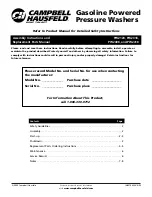
GEAppliances.com
Problem
Possible Cause
What To Do
Water does not enter
Automatic self-system checks
•
After
START
is pressed, the washer does several system checks.
washer or enters slowly
Water will flow several seconds after
START
is pressed.
Water valve screens are stopped up
•
Turn off the water source and remove the water connection hoses
from the upper back of the washer. Use a brush or toothpick to clean
the screens in the machine. Reconnect the hoses and turn the water
back on.
Filter clogged or fill hose may
•
Make sure that the water valve filters (blue and orange screen
be kinked
must be free of solids) on the unit are not clogged. Turn off water
and check filter by disconnecting hose at machine. Check that fill
hoses are not kinked or clogged.
Energy efficiency
•
This is an energy-efficient washer. As a result, the temperature settings
for this washer may be different than for a non-energy-efficient washer.
Insufficient water supply
•
Make sure that the water supply is turned on. Make sure that the
water faucets are turned to their completely open position.
The washer door is open
•
The washer door must be closed for all washer cycle operations.
If the door is opened during the washer operation, all functions
will stop, including water filling.
Incorrect fill hose connection
•
Make sure that the fill hoses connect the hot water supply to the
hot inlet on the washer and the cold water supply to the cold inlet
on the washer (hot to hot, cold to cold).
Water fill optimization
•
Water may not cover the top level of the clothes. This is normal
for this high-efficiency washer. The water fill is optimized by the
system for best wash performance.
Snags, holes, tears, rips
Pens, pencils, nails, screws or
•
Remove loose items from pockets.
or excessive wear
other objects left in pockets
Pins, snaps, hooks, sharp buttons,
•
Fasten snaps, hooks, buttons and zippers.
belt buckles, zippers and sharp
objects left in pockets
Wrinkling
Improper sorting
•
Avoid mixing heavy items (like work clothes) with light items
(like blouses).
Overloading •
Load your washer so clothes have enough room to move freely.
Incorrect wash cycle
•
Match Cycle selection to the type of fabric you are washing
(especially for easy-care loads).
Repeated washing in water that is too hot •
Wash in warm or cold water.
Grayed or yellowed
Not enough detergent
•
Use correct amount of detergent.
clothes
Not using HE (high-efficiency) detergent •
Use HE detergent.
Hard water
•
Use hottest water safe for fabric.
•
Use a water conditioner like Calgon brand or install a water
softener.
Water is not hot enough
•
Make sure water heater is delivering water at
120°–140°F (48°–60°C).
Detergent is not dissolving
•
Try a liquid detergent.
Dye transfer
•
Sort clothes by color. If fabric label states
wash separately,
unstable dyes may be indicated.
Colored spots
Incorrect use of fabric softener
•
Check fabric softener package for instructions and follow
directions for using dispenser.
Dye transfer
•
Sort whites or lightly colored items from dark colors.
•
Promptly remove wash load from washer.
Water temperature
Water supply is improperly
•
Make sure hoses are connected to correct faucets.
is incorrect
connected
House water heater is not set
•
Make sure house water heater is delivering water
properly
at 120°–140°F (48°–60°C).
Bad odor inside
Washer unused for a long time
•
Leave the door slightly open for the water to air dry.
your washer
or not using recommended
•
Run a
Basket Clean
cycle (found in the
Washer
cycles menu)
quality of HE detergent
with 1 cup of bleach or other commercially available product
manufactured for this use such as Tide
®
Washing Machine Cleaner.
See
Care and Cleaning/General Maintenance
in the
Loading and
using the washer section
.
Slight variation
This is normal
•
Due to the metallic properties of paint used for this unique
in metallic color
product, slight variations of color may occur due to viewing
angles and lighting conditions.
21
Consumer S
uppor
t
Tr
oubleshooting Tips
Operating Instructions
Safety Instructions
Installation
Instructions
















































